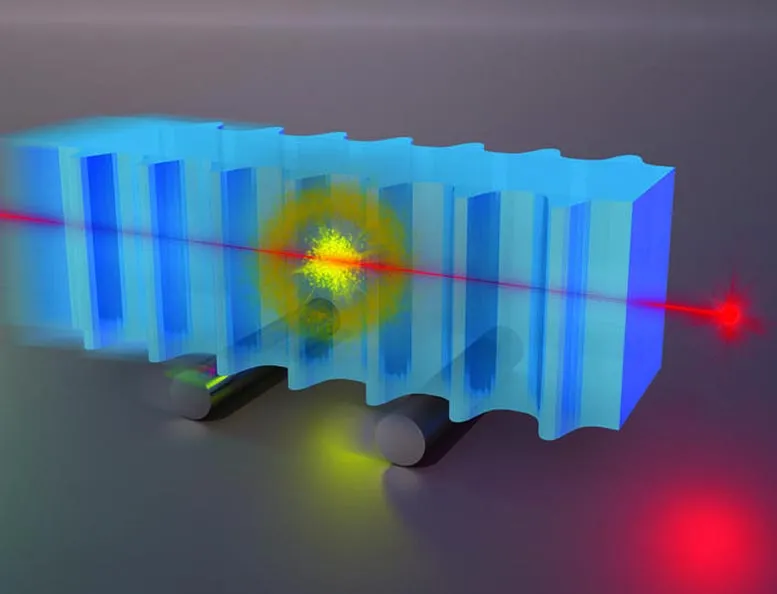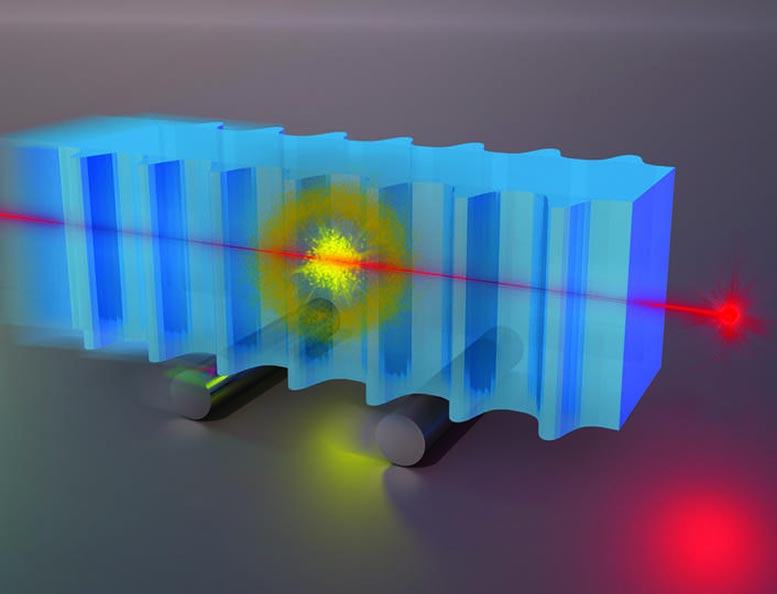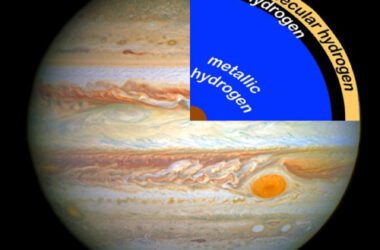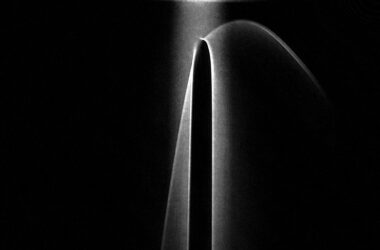Par

Une illustration d’un métamatériau à indice proche de zéro montre que lorsque la lumière le traverse, elle se déplace dans une phase constante. Crédit : Second Bay Studios/Harvard SEAS
Les métamatériaux à indice zéro offrent de nouvelles perspectives sur les fondements de la mécanique quantique.
En physique, comme dans la vie, il est toujours bon de regarder les choses sous différents angles.
Depuis l’aube de la physique quantique, la façon dont la lumière se déplace et interagit avec la matière qui l’entoure a été principalement décrite et comprise mathématiquement à travers le prisme de son énergie. Max Planck s’est servi de l’énergie pour expliquer comment la lumière est émise par des objets chauffés en 1900, une étude déterminante pour la fondation de la mécanique quantique. Albert Einstein a utilisé l’énergie lorsqu’il a introduit le concept de photon en 1905.
Mais la lumière possède une autre qualité, tout aussi importante, appelée momentum. Et il s’avère que lorsque vous enlevez le momentum, la lumière commence à se comporter de manière très intéressante.
Une équipe internationale de physiciens réexamine les fondements de la physique quantique du point de vue de la quantité de mouvement et explore ce qui se passe lorsque la quantité de mouvement de la lumière est réduite à zéro. Les chercheurs sont dirigés par Michaël Lobet, chercheur associé à la Harvard John A. Paulson School of Engineering and Applied Sciences (SEAS) et Eric Mazur, professeur de physique et de physique appliquée à la SEAS, titulaire de la chaire Balkanski,
La recherche a été publiée dans le journal Nature Light Science & ; Applications le 25 avril 2022.
Tout objet ayant une masse et une vitesse possède une quantité de mouvement – des atomes aux balles en passant par les astéroïdes – et la quantité de mouvement peut être transférée d’un objet à un autre. Un pistolet recule lorsqu’une balle est tirée car la quantité de mouvement de la balle est transférée au pistolet. À l’échelle microscopique, un atom recoils when it emits light because of the acquired momentum of the photon. Atomic recoil, first described by Einstein when he was writing the quantum theory of radiation, is a fundamental phenomenon that governs light emission.
But a century after Planck and Einstein, a new class of metamaterials is raising questions regarding these fundamental phenomena. These metamaterials have a refractive index close to zero, meaning that when light travels through them, it doesn’t travel like a wave in phases of crests and troughs. Instead, the wave is stretched out to infinity, creating a constant phase. When that happens, many of the typical processes of quantum mechanics disappear, including atomic recoil.
Why? It all goes back to momentum. In these so-called near-zero index materials, the wave momentum of light becomes zero and when the wave momentum is zero, odd things happen.
“As physicists, it’s a dream to follow in the footsteps of giants like Einstein and push their ideas further. We hope that we can provide a new tool that physicists can use and a new perspective, which might help us understand these fundamental processes and develop new applications.”
— Michaël Lobet, Research Associate, SEAS
“Fundamental radiative processes are inhibited in three dimensional near-zero index materials,” says Lobet, who is currently a lecturer at the University of Namur in Belgium. “We realized that the momentum recoil of an atom is forbidden in near-zero index materials and that no momentum transfer is allowed between the electromagnetic field and the atom.”
If breaking one of Einstein’s rules wasn’t enough, the researchers also broke perhaps the most well-known experiment in quantum physics — Young’s double-slit experiment. This experiment is used in classrooms across the globe to demonstrate the particle-wave duality in quantum physics — showing that light can display characteristics of both waves and particles.
In a typical material, light passing through two slits produces two coherent sources of waves that interfere to form a bright spot in the center of the screen with a pattern of light and dark fringes on either side, known as diffraction fringes.

In the double slit experiment, light passing through two slits produces two coherent sources of waves that interfere to form a bright spot in the center of the screen with a pattern of light and dark fringes on either side, known as diffraction fringes. Credit: Harvard John A. Paulson School of Engineering and Applied Sciences
“When we modeled and numerically computed Young’s double-slit experiment, it turned out that the diffraction fringes vanished when the refractive index was lowered,” said co-author Larissa Vertchenko, of the Technical University of Denmark.
“As it can be seen, this work interrogates fundamental laws of quantum mechanics and probes the limits of wave-corpuscle duality,” said co-author Iñigo Liberal, of the Public University of Navarre in Pamplona, Spain.
While some fundamental processes are inhibited in near-zero refractive index materials, others are enhanced. Take another famous quantum phenomenon — Heisenberg’s uncertainty principle, more accurately known in physics as the Heisenberg inequality. This principle states that you cannot know both the position and speed of a particle with perfect accuracy and the more you know about one, the less you know about the other. But, in near-zero index materials, you know with 100% certainty that the momentum of a particle is zero, which means you have absolutely no idea where in the material the particle is at any given moment.
“This material would make a really poor microscope, but it does enable to cloak objects quite perfectly,” Lobet said. “In some way, objects become invisible.”
“These new theoretical results shed new light on near-zero refractive index photonics from a momentum perspective,” said Mazur. “It provides insights into the understanding of light-matter interactions in systems with a low- refraction index, which can be useful for lasing and quantum optics applications.”
The research could also shed light on other applications, including quantum computing, light sources that emit a single photon at a time, the lossless propagation of light through a waveguide, and more.
The team next aims to revisit other foundational quantum experiments in these materials from a momentum perspective. After all, even though Einstein didn’t predict near-zero refractive index materials, he did stress the importance of momentum. In his seminal 1916 paper on fundamental radiative processes, Einstein insisted that, from a theoretical point of view, energy and momentum “should be considered on a completely equal footing since energy and momentum are linked in the closest possible way.”
“As physicists, it’s a dream to follow in the footsteps of giants like Einstein and push their ideas further,” said Lobet. “We hope that we can provide a new tool that physicists can use and a new perspective, which might help us understand these fundamental processes and develop new applications.”
Reference: “Momentum considerations inside near-zero index materials” by Michaël Lobet, Iñigo Liberal, Larissa Vertchenko, Andrei V. Lavrinenko, Nader Engheta and Eric Mazur, 25 April 2022, Light: Science & Applications.
DOI: 10.1038/s41377-022-00790-z



